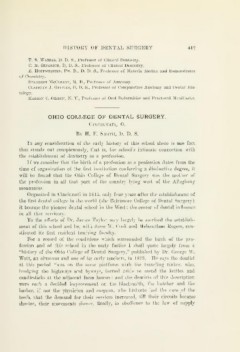Page 459 - My FlipBook
P. 459
HISTORY OF DENTAL SUEGERY 417
T. S. Waters, D. D. S., Professor of Clinical Dentistry.
C. M. Gingrich, D. D. S., Professor of Clinical Dentistry.
E. HOFFMEISTER, Ph. D., D. D. S., Professor of Materia Mediea and Demonstrator
of Chemistry.
Standish McCleary, M. D., Professor of Anatomy.
Clarence J. Grieves, D. D. S., Professor of Comparative Anatomy and Dental His-
tology.
Kasson C. Gibson, N. Y., Professor of Oral Deformities and Fractured Maxillaries.
OHIO COLLEGE OF DENTAL SURGERY.
Cincinnati, 0.
By H. F. Smith, D. D. S.
In any consideration of the early history of this school there is one fact
that stands out conspicuously, that is, the school's intimate connection with
the establishment of dentistry as a profession.
If we consider that the birth of a profession as a profession dates from the
time of organization of the first institution conferring a distinctive degree, it
will be found that the Ohio College of Dental Surgery was the mother of
the profession in all that part of the country lying west of the Alleghany
mountains.
Organized in Cincinnati in 1845, only four years after the establishment of
the first dental college in the world (the Baltimore College of Dental Surgery)
it became the pioneer dental school in the West ; the center of dental influence
in all that territory.
To the efforts of Dr. James Taylor may largely be ascribed the establish-
ment of this school and he, with Jesse W. Cook and Melancthon Rogers, con-
stituted its first resident teaching faculty.
For a record of the conditions which surrounded the birth of the pro-
fession and of this school in the early forties I shall quote largely from a
"history of the Ohio College of Dental Surgery," published by Dr. George W.
Watt, an alumnus and one of its early teachers, in 1879. He says the dentist
at this period "was on the same platform with the traveling tinker, who,
trudging the highways and byways, turned aside to mend the kettles and
candlesticks at the adjacent farm houses : and the dentists of this description
were such a decided improvement on the blacksmith, the butcher and the
barber, if not the physician and surgeon, who hitherto had the care of the
teerh, that the demand for their services increased, till their circuits became
shorter, their movements slower, finally, in obedience to the law of supply


